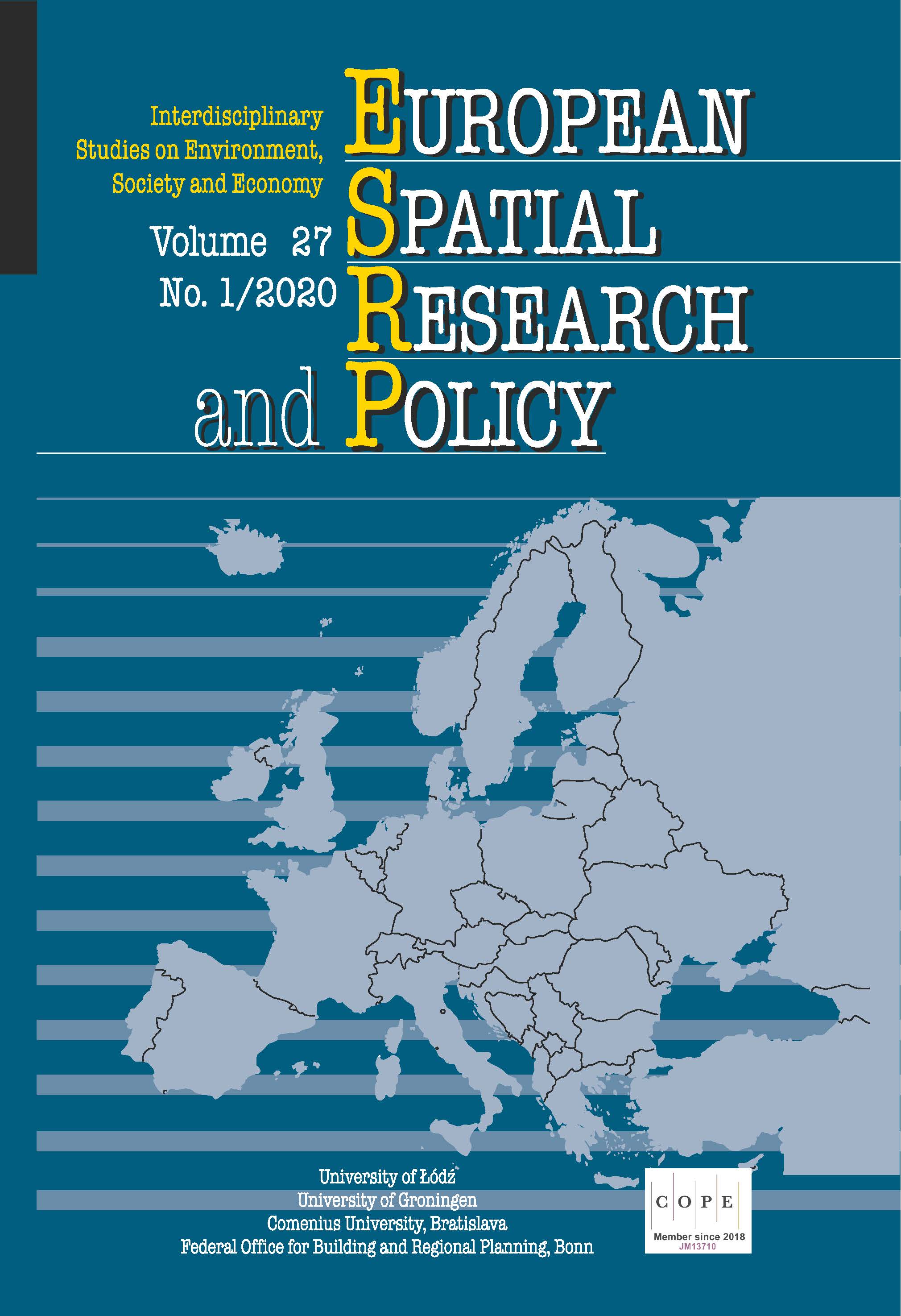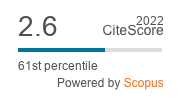Transit in Regional Economic Development: The Case of the Kaliningrad Exclave
DOI:
https://doi.org/10.18778/1231-1952.27.1.12Keywords:
transit, transportation system, regional economy, situational forecasting and strategizing, Kaliningrad regionAbstract
The study analyses the role of the transit function in the development of a regional transport system drawing on the example of the Kaliningrad exclave region (Russia). The article studies the role and extent of the impact of changes in the volume and structure of transit operations on the value-added creation in the regional economy. The assessment of the transit function was conducted using analytical software for strategizing and situational forecasting of the socio-economic development of the Kaliningrad region, the analogue of which is the CGE-model. The article describes the results of the regional value-added modelling based on the integrated index of gross regional product (GRP) and the changing volume and structure of transit cargo. The article explores the transit specialisation options for the Kaliningrad region based on different scenarios of its social and economic development and the changes in external factors. The results can be applied to similar studies on assessing the transit potential of a particular territory and developing measures to support the transportation system development in other regions.
Downloads
References
ANOKHIN, A.A. and FEDOROV, G.M. (2018), ‘O sootnoshenii protsessov polyarizatsii i vyravnivaniya urovnya sotsialno-ekonomicheskogo razvitiya subyektov Rossiyskoy Federatsii’, Vestnik of St Petersburg University. Earth Sciences, 62, pp. 327–342. https://doi.org/10.21638/11701/spbu07.2017.401
Google Scholar
DOI: https://doi.org/10.21638/11701/spbu07.2017.401
BARROS, C.P. and PEYPOCH, N. (2009), ‘An evaluation of European airlines’ operational performance’, International Journal of Production Economics, 122, pp. 525–533. https://doi.org/10.1016/j.ijpe.2009.04.016
Google Scholar
DOI: https://doi.org/10.1016/j.ijpe.2009.04.016
BERNHOFEN, D.M., EL-SAHLI, Z. and KNELLER, R. (2016), ‘Estimating the effects of the container revolution on world trade’, Journal of International Economics, 98, pp. 36–50. https://doi.org/10.1016/j.jinteco.2015.09.001
Google Scholar
DOI: https://doi.org/10.1016/j.jinteco.2015.09.001
BROOKS, M.R. and CULLINANE, K. (2007), Devolution, Port Governance and Port Performance, Research in Transportation Economics, JAI Press.
Google Scholar
BULIS, A. and ŠKAPARS, R. (2013), ‘Development of International Freight Transit in Latvia’, Procedia – Social and Behavioral Sciences, 99, pp. 57–64. https://doi.org/10.1016/j.sbspro.2013.10.471
Google Scholar
DOI: https://doi.org/10.1016/j.sbspro.2013.10.471
BUTTON, K.J. and HENSHER, D.A. (2005), Handbook of Transport Strategy, Policy and Institutions, Elsevier Oxford, UK.
Google Scholar
DOI: https://doi.org/10.1108/9780080456041
CHEN, L. and NOTTEBOOM, T. (2014), ‘A cost perspective on the location of value-added logistics services in supply chains’, International Journal of Logistics Systems and Management (IJLSM), 18, pp. 24–48. https://doi.org/10.1504/ijlsm.2014.062121.
Google Scholar
DOI: https://doi.org/10.1504/IJLSM.2014.062121
CHIU, Y.H., HUANG, C.W. and MA, C.M. (2011), ‘Assessment of China transit and economic efficiencies in a modified value-chains DEA model’, European Journal of Operational Research, 209, pp. 95–103. https://doi.org/10.1016/j.ejor.2010.05.010
Google Scholar
DOI: https://doi.org/10.1016/j.ejor.2010.05.010
CHOW, J.Y.J., YANG, C.H. and REGAN, A.C. (2010), ‘State-of-the art of freight forecast modeling: Lessons learned and the road ahead’, Transportation (Amst), 37, pp. 1011–1030. https://doi.org/10.1007/s11116-010-9281-1
Google Scholar
DOI: https://doi.org/10.1007/s11116-010-9281-1
DEMENTIEV, V.E., USTYUZHANINA, E.V. and EVSUKOV, S.G. (2018), ‘Tsifrovaya transformatsiya tsepochek sozdaniya tsennosti: «ulybka» mozhet okazatsya «khmuroy»’, Journal of Institutional Studies, 10, pp. 58–77. https://doi.org/10.17835/2076-6297.2018.10.4.058-077
Google Scholar
DOI: https://doi.org/10.17835/2076-6297.2018.10.4.058-077
DRUZHININA, G. and DONG,Y. (2018), ‘One Belt – One Road Initiative: A Window of Opportunity for Russia’s Western Border Regions’, Baltiс Region, 10, pp. 39–55. https://doi.org/10.5922/2079-8555-2018-2-3
Google Scholar
DOI: https://doi.org/10.5922/2079-8555-2018-2-3
GAREEV, T.R. and VOLOSHENKO, K.Yu. (2015), ‘Osobennosti postroyeniya balansovoy modeli eksklavnogo regiona’, Econ. Reg, 2, pp. 113–124. https://doi.org/10.17059/2015-2-9
Google Scholar
DOI: https://doi.org/10.17059/2015-2-9
GUMENYUK, I. and MELNIK, D. (2013), ‘The transnational territorial transport system of the Baltic Region’, Baltiс Region, 2, pp. 66–71. https://doi.org/10.5922/2079-8555-2012-1-8
Google Scholar
DOI: https://doi.org/10.5922/2079-8555-2012-1-8
HANSEN, P. and ANNOVAZZI-JAKAB, L. (2008), ‘Facilitating Cross-Border Movement of Goods: A Sustainable Approach’, The Global Enabling Trade Report, World Economic Forum, Geneva, Switzerland. pp. 67–76.
Google Scholar
HAVENGA, J.H. (2018), ‘Logistics and the future: The rise of macrologistics’, Journal of Transport and Supply Chain Management, 12. https://doi.org/10.4102/jtscm.v12i0.336
Google Scholar
DOI: https://doi.org/10.4102/jtscm.v12i0.336
HUMMELS, D.L. and SCHAUR, G. (2013), ‘Time as a trade barrier’, American Economic Review, 103, pp. 2935–2959. https://doi.org/10.1257/aer.103.7.2935
Google Scholar
DOI: https://doi.org/10.1257/aer.103.7.2935
KHAN, A. and THOMAS, J.K. (2007), ‘Inventories and the business cycle: An equilibrium analysis of (S, s) policies’, American Economic Review, 97, pp. 1165–1188. https://doi.org/10.1257/aer.97.4.1165
Google Scholar
DOI: https://doi.org/10.1257/aer.97.4.1165
KUNAKA, C. and CARRUTHERS, R. (2014), Trade and Transport Corridor Management Toolkit, Washington, DC: World Bank. https://doi.org/10.1596/978-1-4648-0143-3
Google Scholar
DOI: https://doi.org/10.1596/978-1-4648-0143-3
LAM, J.S.L. (2012), ‘Benefits and barriers of supply chain integration: empirical analysis of liner shipping’, International Journal of Shipping and Transport Logistics (IJSTL), 5, pp. 13–30. https://doi.org/10.1504/ijstl.2013.050553
Google Scholar
DOI: https://doi.org/10.1504/IJSTL.2013.050553
LITVINENKO, M. and PALŠAITIS, R. (2006), ‘The evaluation of transit transport probable effects on the development of countrys economy’, Transport, 21, pp. 135–140. https://doi.org/ 10.3846/16484142.2006.9638055
Google Scholar
MACHERET, D.A. and EPISHKIN, I.A. (2017), ‘Mutual Influence of Institutional and Transport Factors of Economic Development: Retrospective Analysis’, Journal of Institutional Studies, 9, pp. 80–100. https://doi.org/10.17835/2076-6297.2017.9.4.080-100
Google Scholar
DOI: https://doi.org/10.17835/2076-6297.2017.9.4.080-100
MORRISON, A., RABELLOTTI, R. and PIETROBELLI, C. (2008), ‘Global Value Chains and Technological Capabilities: A Framework to Study Industrial Innovation in Developing Countries’, Oxford Development Studies, 36 (1). https://doi.org/10.4324/9780203937396.ch6
Google Scholar
DOI: https://doi.org/10.4324/9780203937396.ch6
Protocol amending the Marrakesh agreement establishing The World Trade Organization, decision of 27 November 2014., https://docs.wto.org/dol2fe/Pages/SS/directdoc.aspx?filename=q:/WT/L/940.pdf. [accessed on 23.12.2018].
Google Scholar
RODRIGUE, J.P. (2012), ‘Supply chain management, logistics changes and the concept of friction’, [in:] Cities Regions and Flows. https://doi.org/10.4324/9780203106143
Google Scholar
DOI: https://doi.org/10.4324/9780203106143
RODRIGUE, J.P. (2017), The Geography of Transport Systems, Fourth Edition, London.RUTNER, S.M. and LANGLEY, C.J. (2000), ‘Logistics Value: Definition, Process and Measurement’, International Journal of Logistics Management, 11. pp. 73–82. https://doi.org/10.1108/09574090010806173
Google Scholar
DOI: https://doi.org/10.1108/09574090010806173
TAVASSZY, L.A. (2006), ‘Freight Modelling – An overview of international experiences’, TRB Conf. Freight Demand Moddeling Tools Public Sect. Decis. Mak.
Google Scholar
TAVASSZY, L.A. and de JONG, G. (2013), Modelling Freight Transport, Elsevier. https://doi.org/10.1016/C2012-0-06032-2
Google Scholar
DOI: https://doi.org/10.1016/C2012-0-06032-2
TSYBATOV, V.A. (2017), ‘Problemy resursoobosnovannogo tselepolaganiya v zadachakh strategicheskogo planirovaniya regionalnogo razvitiya’, Regional Economy. South of Russia, 1, pp. 67–76. https://doi.org/https://doi.org/10.15688/re.volsu.2017.1.7
Google Scholar
DOI: https://doi.org/10.15688/re.volsu.2017.1.7
VOLOSHENKO, K.Y and PONOMAREV, A.K. (2018), ‘Introducing Sectoral Models into Regional Management: An Assessment of Regulatory Impacts on the Economy’, Baltiс Region, 9, pp. 72–86. https://doi.org/10.5922/2079-8555-2017-4-5
Google Scholar
DOI: https://doi.org/10.5922/2079-8555-2017-4-5
WANG, L., XUE, X., ZHAO, Z. and WANG, Z. (2018), ‘The impacts of transportation infrastructure on sustainable development: Emerging trends and challenges’, International Journal of Environmental Research and Public Health, 15, pp. 1172–1196. https://doi.org/10.3390/ijerph15061172
Google Scholar
DOI: https://doi.org/10.3390/ijerph15061172
YE, M., MENG, B. and WEI, S. (2012), Measuring Smile Curves in Global Value Chains, Institute of. Developing Economies.
Google Scholar
Downloads
Published
How to Cite
Issue
Section
License

This work is licensed under a Creative Commons Attribution-NonCommercial-NoDerivatives 4.0 International License.














